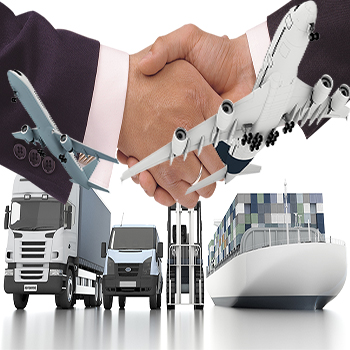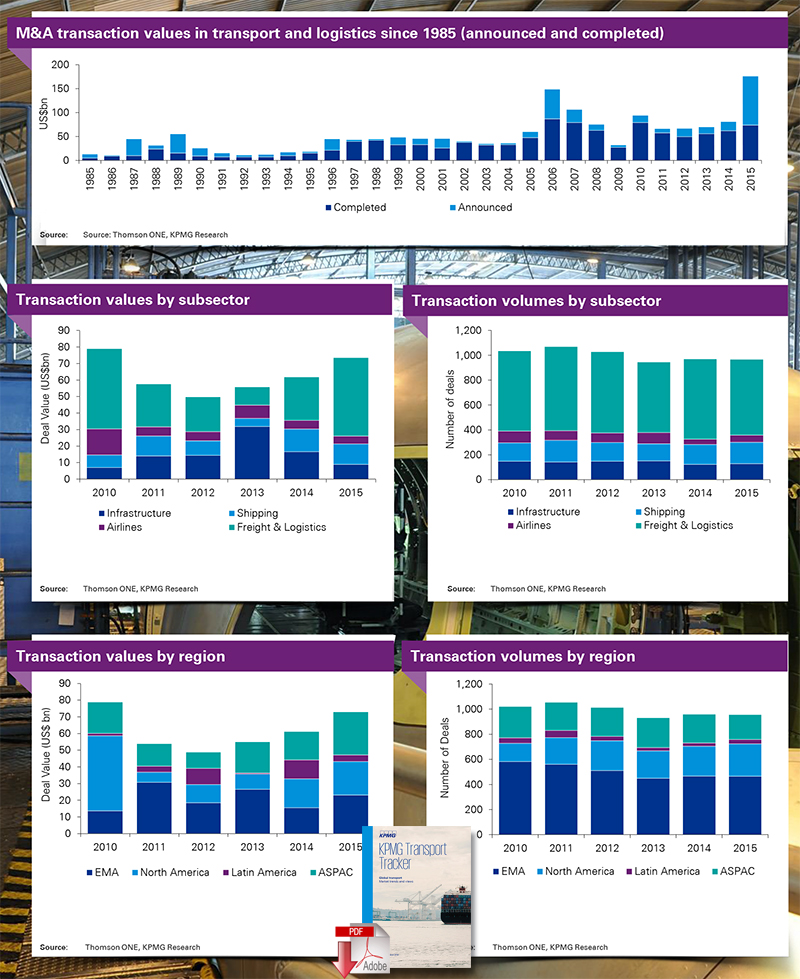Global Transportation and Logistics Mergers & Acquisitions to Pass $73 Billion in 2016

Mergers and acquisition activity in the global transportation and logistics industry is expected to soar past the $73 billion mark this year, this according to the latest Transport Tracker compiled by consulting firm KPMG.
Business model convergence and slower market growth drives M&A activity
2015 was a record year for the transport and logistics sector for various reasons: the total value of M&A transactions and funding for startups both reached all-time highs.
The value of completed M&A transactions rose for the third consecutive year, to a total value of around US$74bn.
Additionally, further transactions worth approximately US$100bn were announced, which set M&A activity in the sector at a record level in 2015.
There are a few drivers for these trends:
The acquisitions made in the sector increasingly serve the transformation of existing business models.
This relates to both the acquisition of logistics companies with high-tech/asset-light business models by asset-based companies and vice versa (asset-light logistics specialists acquiring asset-heavy freight forwarders).
Last year, a number of large transactions, some complementing and some transforming the existing business models could be observed:
- The acquisition of US logistics company Coyote Logistics (high-tech/asset-light business model) by UPS (asset-heavy integrator), worth US$1.8bn (a);
- The acquisition of the French forwarder Norbert Dentressangle (asset-heavy) by XPO Logistics (until the start of numerous acquisitions last year an asset-light logistics operator), worth US$2.8bn; and
- The acquisition of TOLL Logistics by Japan Post, worth US$5bn, in turn, served to transform the existing business model of the postal service provider into a full-service logistics provider.
Traditionally, asset-light logistics service providers with relevant IT systems were popular acquisition targets for large logistics providers and freight forwarders.
The reverse case now applies and the leaner forwarders increasingly look for their own assets and reliable networks in order to support and enhance their services.
In addition to this, the plateau effect of globalization makes organic growth ever harder to achieve for logistics companies, which in turn drives M&A activity in the sector. World trade consensus forecasts are now significantly lower than several years ago.
One reason for this is that the global division of labor, which had risen rapidly during the last decades, has gradually reached its plateau and therefore cannot be expected to increase indefinitely. This means that in the future, there will be fewer additional growth effects as part of an increasing globalization of trade flows.
As a consequence, the world-trade-GDP multiplier (the factor by which the world trade grows faster than global GDP) has decreased from 3.5x in the 1990s, to 1.4x today, where it will remain for a number of years.
Against the backdrop of this new growth consensus, the major companies in the sector are increasingly looking for ways to compensate for the slower market dynamics through inorganic growth. Examples include:
- The announced acquisition of the shipping line NOL by CMA CGM, worth US$2.4bn;
- The intended acquisition of Norfolk Southern by Canadian Pacific Railway, worth US$27.5bn; and
- FedEx’s acquisition of TNT Express, worth US$4.7bn.
SC24/7 Topic: Mergers & Acquisitions
Competition for customer interface drives investments in logistics startups
In addition to M&A investments, the funding of startups from the transport and logistics sector accelerated in 2015 with a total global funding volume of US$14bn, some 180 percent more than last year and a further 500 percent more than the average of the four years before that.
This figure includes investments in carsharing and mobility unicorns, such as Lyft and UBER, which are increasingly disrupting the traditional markets of large transportation companies.
In addition to startups with passenger transportation business models, new market players with a focus on logistics and forwarding are entering the arena.
Investment in these startups rose by 125 percent to US$1.5bn last year and are around 85 percent higher than the average of the four years before that. This number includes agile business models within the eCommerce environment, which offer crowd-logistics and platform-based solutions for the delivery of online orders.
These startups focus almost exclusively on the asset-free coordination of processes through software platforms and enable the direct interface of online shoppers with delivery providers. Examples include:
- Postmates, total funding of US$138mn (b);
- Shyp, total funding of US$62mn and Deliv, total funding of US$40mn.
But even in the B2B sector, new startups are now offering services similar to Freight Forwarders. Their business model mostly focuses on the brokerage of freight rates and the coordination of transportation chains through IT-based platforms.
While the international freight forwarders are often still using analog processes for the negotiation of freight rates, the startups are positioning themselves directly between the shipper and the carrier through their digital platform solutions and are thus threatening the business model of the major freight forwarders. Examples are:
- Freightos, total funding of US$37mn;
- Flexport, total funding of US$27mn; and
- Efreightsolutions, total funding of US$19mn.
What all of these startups have in common is that they enable the end customers (B2B or B2C) to directly steer their transportation chains without an intervening logistics service provider.
The larger transportation and logistics companies are thus at risk of losing their most important asset: the customer interface.
In the next few years we can expect investment activities in the transport and logistics sector to remain high. While many companies will be focusing on the integration of recent acquisitions, there are numerous other strategic investors willing to use their cash reserves for other medium to large-scale acquisitions.
Other companies are changing their business model and will therefore divest business units, which will lead to a high availability of target companies.
Looking at the dynamic startups, we can expect to see a further increase in venture capital investments in the sector. The billion-dollar market for transport and logistics services has only recently been discovered by venture capital investors as a sector that is ready to be significantly disrupted. In the face of the forthcoming challenges, such as the rapidly progressing digitalization of business processes and ever growing eCommerce, the flexible and innovative startups will be best equipped to respond to such trends and offer new solutions.
Therefore, it is only a matter of time before strategic investors mark them as acquisition targets to complement existing business models.
Dr Steffen Wagner
Global Chair, Transport & Logistics
KPMG in Germany
Source: KPMG Transport & Logistics
Article Topics
KPMG News & Resources
Supply Chain Stability Index sees ‘Tremendous Improvement’ in 2023 Supply Chain Stability Index: “Tremendous Improvement” in 2023 Supply chain stability remains elusive, notes new report from ASCM and KPMG Elevated freight and labor costs remain issues for stressed out supply chains New index by ASCM and KPMG shows supply chain stress level more than doubled in past two years DoD picks KPMG to assist on 5G application for Marine Corp’s smart warehouse project Conventional warehouse tune up More KPMGLatest in Supply Chain
U.S. Manufacturing is Growing but Employment Not Keeping Pace The Two Most Important Factors in Last-Mile Delivery Most Companies Unprepared For Supply Chain Emergency Microsoft Unveils New AI Innovations For Warehouses Let’s Spend Five Minutes Talking About ... Malaysia Baltimore Bridge Collapse: Impact on Freight Navigating TIm Cook Says Apple Plans to Increase Investments in Vietnam More Supply Chain














